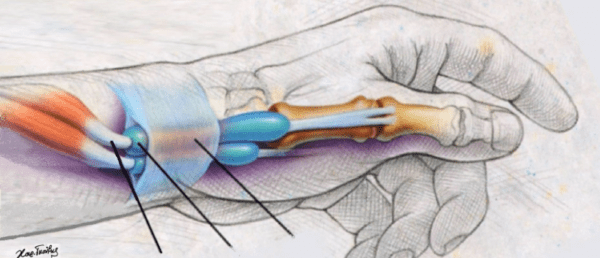Hey Everyone! I have a special interest in hands and wrists, and today I thought I should share some info about a common condition that we see in the clinic. It is called De Quervain’s Tenosynovitis, which is a condition that affects tendons at the base of your thumb.
What is it?
There are two tendons at the back of your thumb called the APL and EPB (with the unreasonably long names of Adductor Pollicis Longus and Extensor Pollicis Brevis) . These tendons travel through a little tunnel in the back of thumb and connect to the muscles in the forearm. When these two tendons are working harder than normal, they start to rub on the inside of the tunnel, which can make them angry and inflamed. When this continues, the tendons can even grow in response, which makes the tunnel even more constricted.
Who gets it?
Any big increase in repetitive activity that includes wrist and thumb movement with gripping can result in De Quervain’s. It is especially common in mothers with newborns who have to lift their baby, or support a baby’s head with their wrist and thumb while breastfeeding. Other repetitive wrist activity such as tennis, playing piano or typing can result in this condition.
What does it feel like?
This condition typically presents with shooting pain down the back of the thumb and into the wrist. Other symptoms can include aching, burning and a stretching sensation. This feels worse during the repetitive activity that is causing the problem. We sometimes see swelling and stiffness in the surrounding joints and it is generally very tender to the touch.
How is it treated?
The first treatment for De Quervain’s is avoiding the aggravating activity. This means either cutting down the hours on the tennis court or limiting piano practice time. Sometimes though when the condition is quite severe or the activity can’t be avoided (i.e. newborn mums or occupation related movement) a support brace or splint is required. This will limit the movement of the wrist and thumb to give those tendons a proper break. A heat pack might be helpful for some relief and sometimes anti-inflammatory medication might be indicated. Physiotherapy can also provide soft tissue release and exercises to strengthen the entire wrist and thumb so De Quervain’s does not develop again.
So there you have it! I hope you have a little more knowledge about the condition, and if you have symptoms that present like this please book in (sooner rather than later!) so we can help you return to pain free activity.
